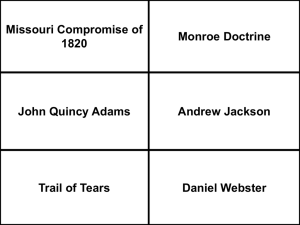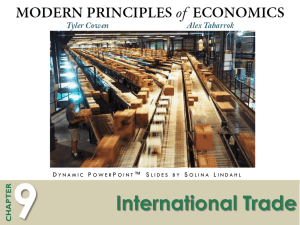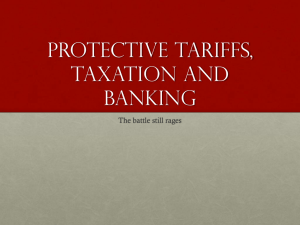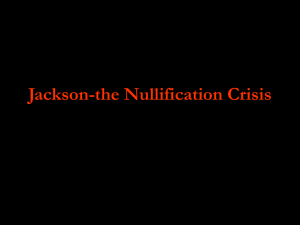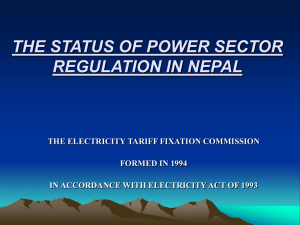Chapter 9
advertisement
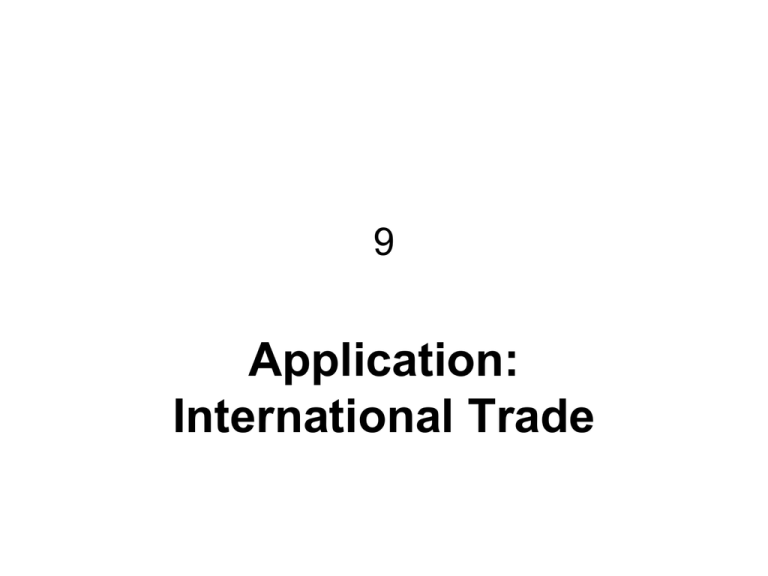
9 Application: International Trade International Trade: issues • What determines whether a country imports or exports a good? • Who gains and who loses from free trade among countries? • What are the arguments that people use to advocate trade restrictions? CHAPTER 9 APPLICATION: INTERNATIONAL TRADE 2 Figure 1The Equilibrium without International Trade Price of Steel Domestic supply Consumer surplus Equilibrium price Producer surplus Domestic demand 0 Equilibrium quantity Quantity of Steel The World Price and Comparative Advantage • If the country decides to engage in international trade, will it be an importer or exporter of steel? CHAPTER 9 APPLICATION: INTERNATIONAL TRADE 5 The World Price and Comparative Advantage • The effects of free trade can be shown by comparing the domestic price of a good (in the absence of trade) and the world price of the good. – The world price is the price that prevails in the world market for that good. CHAPTER 9 APPLICATION: INTERNATIONAL TRADE 6 The World Price and Comparative Advantage • If a country has a comparative advantage in steel production, then its domestic price will be less than the world price • In this case, the country will be an exporter of the good. CHAPTER 9 APPLICATION: INTERNATIONAL TRADE 7 The World Price and Comparative Advantage • If the country does not have a comparative advantage, then the domestic price will be higher than the world price, and • this country will be an importer of the good. CHAPTER 9 APPLICATION: INTERNATIONAL TRADE 8 Figure 2 International Trade in an Exporting Country Price of Steel Domestic supply Price after trade World price Price before trade Exports 0 Domestic quantity demanded Domestic demand Domestic quantity supplied Quantity of Steel Figure 2 How Free Trade Affects Welfare in an Exporting Country Price of Steel Price after trade Domestic supply Exports A B Price before trade World price D C Domestic demand 0 Quantity of Steel The Gains and Losses from trade for an Importing Country • If the world price of steel is lower than the domestic price, the country will be an importer of steel when trade is permitted. • Domestic buyers will want to buy steel at the lower world price. • Domestic producers of steel will have to reduce their output because the domestic price will fall to the world price. CHAPTER 9 APPLICATION: INTERNATIONAL TRADE 11 Figure 3 International Trade in an Importing Country Price of Steel Domestic supply Price before trade Price after trade World price Imports 0 Domestic quantity supplied Domestic quantity demanded Domestic demand Quantity of Steel Figure 3 How Free Trade Affects Welfare in an Importing Country Price of Steel Domestic supply A Price before trade Price after trade B C D Imports World price Domestic demand 0 Quantity of Steel The Gains and Losses from trade for an Importing Country • Domestic producers of the imported good are worse off • Domestic consumers of the imported good are better off. • Trade raises the economic well-being of the nation as a whole – That is, the gains of consumers exceed the losses of producers. CHAPTER 9 APPLICATION: INTERNATIONAL TRADE 14 The Winners And Losers From Trade • Irrespective of whether a country exports a good or imports it, the gains of those who gain exceed the losses of those who lose. • That is, the net change in total surplus is always positive. • And yet, tariffs/taxes on imported goods are quite popular. Why? CHAPTER 9 APPLICATION: INTERNATIONAL TRADE 15 TARIFFS CHAPTER 9 APPLICATION: INTERNATIONAL TRADE 16 The Effects of a Tariff • A tariff is a tax on goods produced abroad and sold domestically. • Tariffs raise the price of imported goods above the world price by the amount of the tariff. – Domestic price = World price + Tariff • This reduces trade and, therefore, the benefits of trade CHAPTER 9 APPLICATION: INTERNATIONAL TRADE 17 Figure 4 The Effects of a Tariff Price of Steel Domestic supply Equilibrium without trade Price with tariff Tariff Price without tariff 0 Imports with tariff S Q S Domestic demand D Q Q Imports without tariff D Q World price Quantity of Steel Figure 4 The Effects of a Tariff Price of Steel Consumer surplus before tariff Producer surplus before tariff Domestic supply Equilibrium without trade Price without tariff 0 Domestic demand S D Q Q Imports without tariff World price Quantity of Steel Figure 4 The Effects of a Tariff Price of Steel Consumer surplus with tariff A Domestic supply Equilibrium without trade B Price with tariff Tariff Price without tariff 0 Imports with tariff S Q S Domestic demand D Q Q Imports without tariff D Q World price Quantity of Steel Figure 4 The Effects of a Tariff Price of Steel Domestic supply Producer surplus after tariff Price with tariff Equilibrium without trade Tariff C Price without tariff G 0 Imports with tariff S Q S Domestic demand D Q Q Imports without tariff D Q World price Quantity of Steel Figure 4 The Effects of a Tariff Price of Steel Domestic supply Tariff Revenue Price with tariff Tariff E Price without tariff 0 Imports with tariff S Q S Domestic demand D Q Q Imports without tariff D Q World price Quantity of Steel Figure 4 The Effects of a Tariff Price of Steel Domestic supply A Deadweight Loss B Price with tariff Tariff C D Price without tariff G 0 E F Imports with tariff S Q S Domestic demand D Q Q Imports without tariff D Q World price Quantity of Steel The Effects of a Tariff • A tariff reduces the quantity of imports and moves the domestic market closer to the no-trade equilibrium. • Buyers of the imported good are worse off • Domestic sellers are better off • Total surplus decreases by an amount referred to as a deadweight loss. – That is, the loss to the nation’s buyers of the import-competing good exceed the gains to the nation’s sellers of that good CHAPTER 9 APPLICATION: INTERNATIONAL TRADE 24 The Lessons for Trade Policy • Tariffs – raise domestic prices. – reduce the welfare of domestic consumers. – increase the welfare of domestic producers. – cause deadweight losses. • Free trade maximizes total surplus CHAPTER 9 APPLICATION: INTERNATIONAL TRADE 25 The Lessons for Trade Policy • Other benefits of international trade – Increased variety of goods – Lower costs through economies of scale – Increased competition – Enhanced flow of ideas CHAPTER 9 APPLICATION: INTERNATIONAL TRADE 26 The Arguments For Restricting Trade • • • • Jobs are shipped abroad National Security is endangered Infant Industries need to be shielded Unfair Competition – Cheap labor – Lax environmental standards • Hard for domestic regulators to keep out defective or harmful imported goods • Protection-as-a-Bargaining Chip • Increasing inequality 27 CASE STUDY: Trade Agreements and the World Trade Organization • Unilateral: when a country removes its trade restrictions on its own. • Multilateral: a country reduces its trade restrictions while other countries do the same. CHAPTER 9 APPLICATION: INTERNATIONAL TRADE 28 CASE STUDY: Trade Agreements and the World Trade Organization • Unilateral: – politically difficult to achieve – Negative terms-of-trade effect for a large country • Multilateral: – politically easier to achieve because exporters can be mobilized to oppose the importcompeting industries that oppose free trade – Less risk of negative terms-of-trade effect 29 CASE STUDY: Trade Agreements and the World Trade Organization • NAFTA – The North American Free Trade Agreement (NAFTA) is an example of a multilateral trade agreement. – In 1993, NAFTA lowered the trade barriers among the united states, Mexico, and Canada. CHAPTER 9 APPLICATION: INTERNATIONAL TRADE 30 CASE STUDY: Trade Agreements and the World Trade Organization • GATT – The General Agreement on Tariffs and Trade (GATT) refers to a continuing series of negotiations among many of the world’s countries with a goal of promoting free trade. – GATT has successfully reduced the average tariff among member countries from about 40 percent after WWII to about 5 percent today. CHAPTER 9 APPLICATION: INTERNATIONAL TRADE 31 Summary • The effects of free trade can be determined by comparing the domestic price without trade to the world price. – A low domestic price indicates that the country has a comparative advantage in producing the good and that the country will become an exporter. – A high domestic price indicates that the rest of the world has a comparative advantage in producing the good and that the country will become an9 APPLICATION: importer. CHAPTER INTERNATIONAL TRADE 32 Summary • When a country allows trade and becomes an exporter of a good, producers of the good are better off, and consumers of the good are worse off. • When a country allows trade and becomes an importer of a good, consumers of the good are better off, and producers are worse off. CHAPTER 9 APPLICATION: INTERNATIONAL TRADE 33 Summary • A tariff—a tax on imports—moves a market closer to the equilibrium than would exist without trade, and therefore reduces the gains from trade. • Import quotas will have effects similar to those of tariffs. CHAPTER 9 APPLICATION: INTERNATIONAL TRADE 34 Summary • There are various arguments for restricting trade: protecting jobs, defending national security, helping infant industries, preventing unfair competition, and responding to foreign trade restrictions. • Economists, however, believe that free trade is usually the better policy. CHAPTER 9 APPLICATION: INTERNATIONAL TRADE 35
